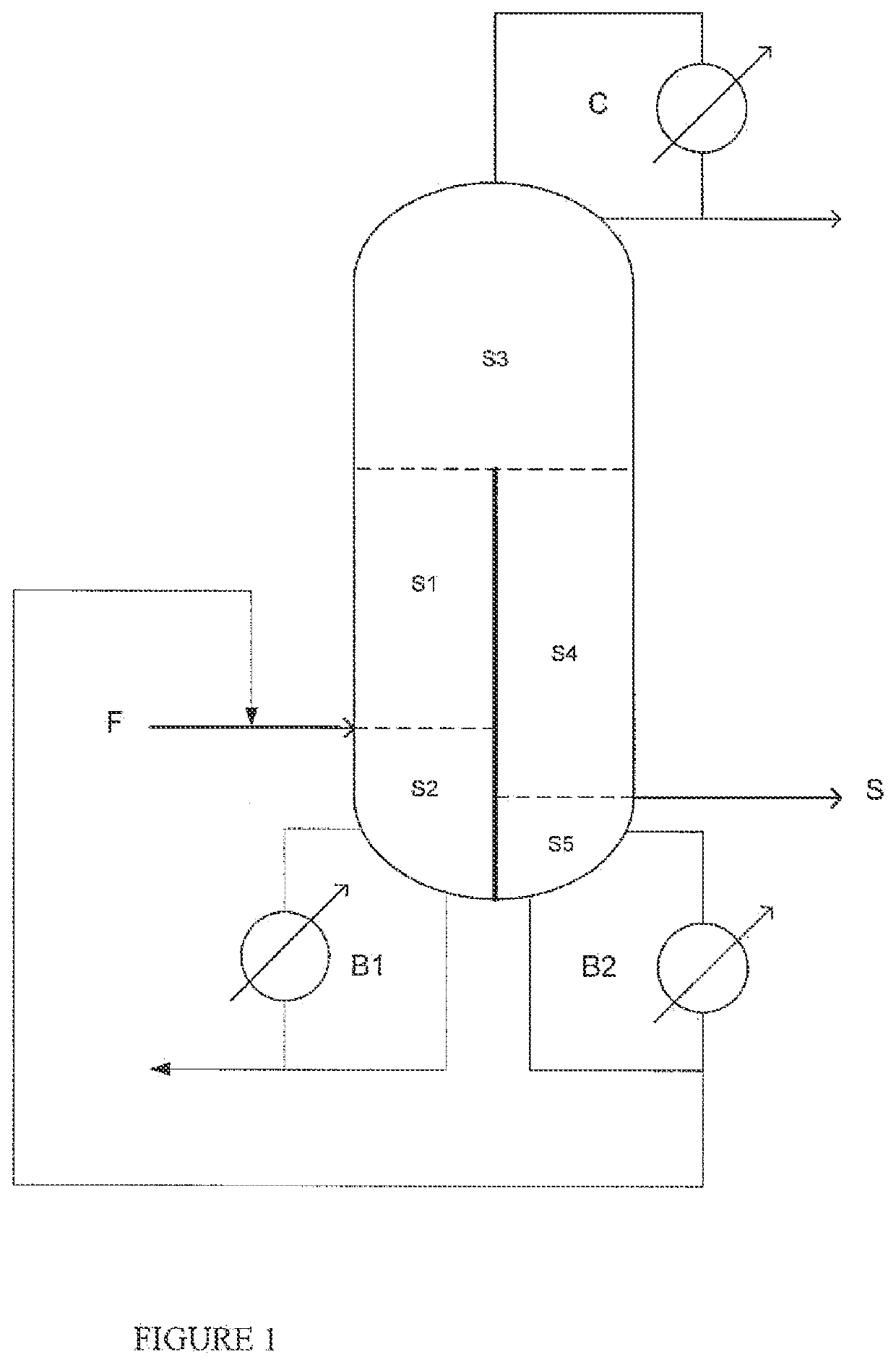Method for purifying (METH)acrylic esters using a divided wall column
a technology of acrylic esters and divided walls, which is applied in the preparation of carboxylic acid esters, chemistry apparatus and processes, and organic chemistry, etc., can solve the problems of complex implementation of purification operations, problems of degradation of acrylic esters, and high cost of operations
- Summary
- Abstract
- Description
- Claims
- Application Information
AI Technical Summary
Benefits of technology
Problems solved by technology
Method used
Image
Examples
example 2
Comparative
[0093]A crude reaction mixture resulting from the synthesis by esterification of acrylic acid with 2-ethylhexanol was subjected to a purification treatment using a dividing wall column such as that described in example 1 of document WO 2018 / 114429.
[0094]Simulation using ASPEN Plus software was carried out fora reaction mixture having the following composition by mass:
[0095]2EHA: 95%
[0096]2-ethylhexanol (2EHOH): 1.5%
[0097]2-ethylhexyl 2-ethylhexylpropionate (OOP): 0.76%
[0098]2-ethylhexyl beta-hydroxypropionate (2EHHP): 2.4%
[0099]2-ethylhexyl acetate (2EHAC): 0.22%
[0100]The pressure at the column top is 25 mmHg, the loss of head of the column was set at 48 mmHg.
[0101]The top product flow rate is 5462 kg / h and the bottom product flow rate is 1200 kg / he
[0102]The column comprises 26 theoretical stage total. The bottom temperature is 143° C., the top temperature is 111° C.
[0103]A mass concentration profile (stage 1: column top; stage 26: column bottom) for the whole column is t...
example 3
According to the Invention
[0109]A simulation was carried out using the ASPEN us software for a purification system as shown in the appended FIGURE.
[0110]The feed is identical to that of example 2, with addition at the boiler of the prefractionation section of 1000 ppm of 2-ethylhexanol in order to simulate cracking.
[0111]The number of plates of the. different sections is as follows:
[0112]N1: 12—N2: 2—N3: 12—N4: 8—N5: 6
[0113]In this configuration, 2EHA with a purity of greater than 99.7% was obtained with a residual 2-ethylhexanol content of 50 ppm.
[0114]According to the invention, a separating wall extending as far as the bottom of the column makes k possible to prevent the back-cracking products such as 2-ethylhexanol from contaminating the product withdrawn as a sidestream.
[0115]This example confirms the importance of the positioning of the separating wall in the dividing wall column for the quality of the product obtained in sidestream withdrawal, in particular the need to have a...
example 4
2-octyl Acrylate Tailing
[0116]This test was carried out using a pilot column of ND 200 mm to characterize the back-cracking phenomena which can also arise in a process for manufacturing 2-octyl acrylate starting from 2-octanol and acrylic acid.
[0117]The main impurities present in the feed of the column, in the bottom of the column and in the top of the column are presented in table 4 below.
TABLE 4O / IColumnColumnbalanceMass balance, %Feedbottomtop(%)Mass flow rate (kg / h)652441Acrylic acid0.00750.02650.0252412-Octyl acrylate99.696599.242799.713502-Octanol0.06870.1820.1323119Octenes0.03890.16250.1267260AA + alcohol0.18650.3856−24Phenol0.00010.00010.0002632-Octyl acetate0.00180.00060.0023−7
[0118]The balance between the output and the input O / I makes it possible to verify the variation in the species present in the streams.
[0119]During this distillation, a great increase in the content of acrylic acid, 2-octanol and octenes is observed, which indicates that the reaction mixture undergoes...
PUM
| Property | Measurement | Unit |
|---|---|---|
| mass fraction | aaaaa | aaaaa |
| mass fraction | aaaaa | aaaaa |
| temperature | aaaaa | aaaaa |
Abstract
Description
Claims
Application Information
 Login to View More
Login to View More - R&D
- Intellectual Property
- Life Sciences
- Materials
- Tech Scout
- Unparalleled Data Quality
- Higher Quality Content
- 60% Fewer Hallucinations
Browse by: Latest US Patents, China's latest patents, Technical Efficacy Thesaurus, Application Domain, Technology Topic, Popular Technical Reports.
© 2025 PatSnap. All rights reserved.Legal|Privacy policy|Modern Slavery Act Transparency Statement|Sitemap|About US| Contact US: help@patsnap.com

